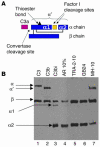Targeted and restricted complement activation on acrosome-reacted spermatozoa
- PMID: 15849610
- PMCID: PMC1077172
- DOI: 10.1172/JCI23213
Targeted and restricted complement activation on acrosome-reacted spermatozoa
Abstract
A specific hypoglycosylated isoform of the complement regulator membrane cofactor protein (MCP; CD46) is expressed on the inner acrosomal membrane (IAM) of spermatozoa. This membrane is exposed after the acrosome reaction, an exocytosis event that occurs upon contact with the zona pellucida. We initiated this investigation to assess MCP's regulatory function in situ on spermatozoa. Upon exposure of human spermatozoa to autologous serum or follicular fluid, we unexpectedly observed that acrosome-reacted spermatozoa activated the complement cascade efficiently through C3 but not beyond. Using FACS to simultaneously evaluate viability, acrosomal status, and complement deposition, we found that complement activation was initiated by C-reactive protein (CRP) and was C1q, C2, and factor B dependent. This pattern is consistent with engagement of the classical pathway followed by amplification through the alternative pathway. C3b deposition was targeted to the IAM, where it was cleaved to C3bi. Factor H, and not MCP, was the cofactor responsible for C3b cleavage. We propose that this localized deposition of complement fragments aids in the fusion process between the spermatozoa and egg, in a role akin to that of complement in immune adherence. In addition, we speculate that this "targeted and restricted" form of complement activation on host cells is a common strategy to handle modified self.
Figures







Similar articles
-
Rat membrane cofactor protein (MCP; CD46) is expressed only in the acrosome of developing and mature spermatozoa and mediates binding to immobilized activated C3.Biol Reprod. 2004 Oct;71(4):1374-83. doi: 10.1095/biolreprod.104.030114. Epub 2004 Jun 23. Biol Reprod. 2004. PMID: 15215199
-
Progesterone promotes the acrosome reaction in capacitated human spermatozoa as judged by flow cytometry and CD46 staining.Mol Hum Reprod. 1999 Jun;5(6):507-12. doi: 10.1093/molehr/5.6.507. Mol Hum Reprod. 1999. PMID: 10340996
-
Identification and characterization of membrane cofactor protein of human spermatozoa.J Immunol. 1992 Mar 1;148(5):1431-7. J Immunol. 1992. PMID: 1538128
-
Mammalian sperm acrosome: formation, contents, and function.Arch Biochem Biophys. 2000 Jul 15;379(2):173-82. doi: 10.1006/abbi.2000.1880. Arch Biochem Biophys. 2000. PMID: 10898932 Review.
-
Pathways of complement activation in membranoproliferative glomerulonephritis and allograft rejection.Transplant Proc. 1977 Mar;9(1):729-39. Transplant Proc. 1977. PMID: 325806 Review.
Cited by
-
Alternative pathway activation in pregnancy, a measured amount "complements" a successful pregnancy, too much results in adverse events.Immunol Rev. 2023 Jan;313(1):298-319. doi: 10.1111/imr.13169. Epub 2022 Nov 15. Immunol Rev. 2023. PMID: 36377667 Free PMC article. Review.
-
Morbillivirus receptors and tropism: multiple pathways for infection.Front Microbiol. 2012 Mar 1;3:75. doi: 10.3389/fmicb.2012.00075. eCollection 2012. Front Microbiol. 2012. PMID: 22403577 Free PMC article.
-
The role of complement in antibody mediated transplant rejection.Mol Immunol. 2019 Aug;112:240-246. doi: 10.1016/j.molimm.2019.06.002. Epub 2019 Jun 10. Mol Immunol. 2019. PMID: 31195225 Free PMC article. Review.
-
Associations between free fatty acids, cumulus oocyte complex morphology and ovarian function during in vitro fertilization.Fertil Steril. 2011 May;95(6):1970-4. doi: 10.1016/j.fertnstert.2011.01.154. Epub 2011 Feb 26. Fertil Steril. 2011. PMID: 21353671 Free PMC article. Clinical Trial.
-
Monoclonal antibody detection of CD46 clustering beneath Neisseria gonorrhoeae microcolonies.Infect Immun. 2006 Apr;74(4):2428-35. doi: 10.1128/IAI.74.4.2428-2435.2006. Infect Immun. 2006. PMID: 16552073 Free PMC article.
References
-
- Ballard LL, Bora NS, Yu GH, Atkinson JP. Biochemical characterization of membrane cofactor protein of the complement system. J. Immunol. 1988;141:3923–3929. - PubMed
-
- Dorig RE, Marcil A, Chopra A, Richardson CD. The human CD46 molecule is a receptor for measles virus (Edmonston strain) Cell. 1993;75:295–305. - PubMed
Publication types
MeSH terms
Substances
Grants and funding
LinkOut - more resources
Full Text Sources
Research Materials
Miscellaneous

